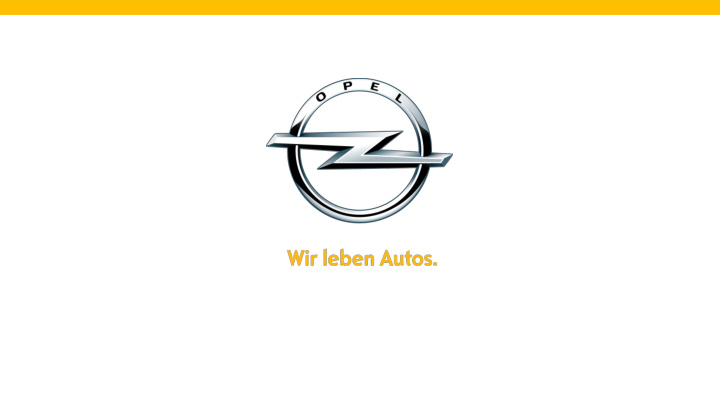



A MASTER MODEL APPROACH FOR SYSTEM SIMULATION USING IPG CARMAKER Dr. Jochen Schaffnit Adam Opel AG, Vehicle CAE apply & innovate 2014 23. September 2014 www.opel.com
AGENDA 1. CarMaker Usage at Opel 2. Challenges for Model/CarMaker File Development and Organization 3. Master Model Approach 4. Summary 3
CarMaker usage at Opel SOME EXAMPLES FOR CARMAKER USAGE ADAS test and validation (HIL) Active Safety: Subsystem requirement definition (Offline Simulation/MIL) Controls feature (pre-)calibration (HIL) Chassis control systems optimization (SIL) 4
CarMaker usage at Opel DIFFERENT TASKS REQUIRE DIFFERENT MODELS • Opel utilizes CarMaker in many different departments for different tasks • CarMaker for Simulink extended with internally developed Simulink models is used in offline-/MIL-, SIL- and HIL-simulation • Model requirements are defined by: • functional focus time of simulation usage during development process • • Many people using/developing simulation models, test runs, parameter files etc. • Future system development (e.g. ADAS, Car2X, autonomous driving) requires increasing usage of simulation techniques and efficient development processes 5
Challenges How to avoid „ silo- mentality“ and parallel development ? • • How to commonly share models/CM files? • How to assure a common model quality (e.g. everybody benefits from bug fixes)? • How to document which model/calibration release was used for testing? • How to enable individual model customization? 6
Master Model Approach WHAT IS A “MASTER MODEL”? • A Master Model is a CarMaker for Simulink model template for offline- simulation/MIL/SIL and HIL applications (usable in CM HIL and CM Office) • Based on this template, a model individually tailored to a specific use case can be build up • Adaptation is done by selecting sub-models from model libraries (identical for offline-simulation/MIL/SIL and HIL applications) • Database (IBM Rational Synergy) is the “gold source” for all files and manages version control and configuration management 7
Library 1 Master Model Approach Library m Database Master Model Master Model Master Model User 1 User 2 User n 8
Master Model Approach DATABASE CONFIGURATION • Database mirrors CM folder structure • “CM for Simulink” folder contains the Master Model templates and all necessary “ init ” files • Model adaptation is done by selecting according sub-model from libraries • CM files (e.g. test runs) are organized in CM datapool library usage of “Data Pool” feature available since CarMaker 4.5 • Individual database projects can be established to handle customized use cases • Database allows to reconstruct a functional model configuration at any time ( baseline) 9
Master Model Approach MODEL CONVENTIONS • Many different users are developing models/libraries • Model conventions defined for: • Model composition • Signal names • Parameter names • File names • Quantities • Acronyms and abbreviations • A common style guide assures model exchangeability • Conventions support unambiguous model understandability 10
Master Model Approach MODEL CONFIGURATION • Sub-model variations are organized in special libraries (internal development) • Different model configurations/default settings can be saved and reused • Blocks can be exchanged anywhere in the model hierarchy without breaking links of upper level subsystems • Parametrization concept: • Library blocks have optional local parameter files • Parser identifies unused/missing parameters • Parameters can be inherited to sub-libraries • Model libraries are strictly separated from CM model usage not limited to CM 11
Master Model Approach MODEL CONFIGURATION 12
Master Model Approach MODEL CONFIGURATION • HIL benches: I/O configurations are documented in Excel-sheets • I/O Maker tool (internal development) automatically generates according interface blocks based on Excel-sheet information • CAN configurations are automatically generated based on DBC database version CAN and I/O signal manipulation: DVA tool (internal development) automatically • generates DVA access points according to signal naming convention • Excel-sheet containing signals for manipulation is basis for DVA tool 13
Summary MASTER MODEL APPROACH ADVANTAGES Master Model approach • • enables shared usage of models and CM files • supports development during complete development cycle (V-process) • assures consistent model quality • guarantees common benefit from model enhancements and bug fixes • enables individual model customization Database manages version control and configuration management • • Individual database projects can be established to handle customized use cases Joint development reduces development time and cost, avoids duplication of effort and • increases quality & process reliability • Efficient simulation for future development challenges (e.g. Car2X, ADAS etc.) 14
Recommend
More recommend